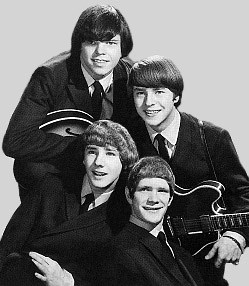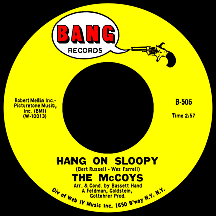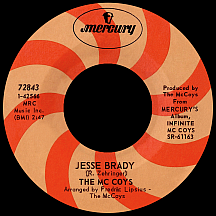THE McCOYS
Hang On Sloopy
Enterprising songwriter-producer Bert Berns lucked onto a plan for doubling the proceeds on certain original compositions. "Twist and Shout," a hit in 1962 for The Isley Brothers that he and Phil Medley had written, yielded an unexpected windfall two years later when British phenom The Beatles had an even bigger hit with the song. Around that same time (spring '64), Chicago-based group The Vibrations scored with "My Girl Sloopy," which Bert had written with Wes Farrell; he reasoned that if he could remake the "Sloopy" song with a group possessing an image similar to the famous mop-topped quartet that he might be able to once again make lightning strike twice. The plan worked...but only after he located a band with the desired image. The McCoys became the beneficiaries by being in the right place at the right time.
Celina, Ohio-born Rick Zehringer was raised in nearby Fort Recovery, Ohio, near the Indiana border. Rick began playing guitar in 1956 at age nine, inspired by the quickly-rising rock and roll movement spearheaded by Elvis Presley; by the early '60s, the Zehringer family had moved 35 miles south to Union City on the Indiana side. He and two-years-younger brother Randy (who'd taken up drums) began practicing with a neighbor kid, bass player Dennis Kelly. As The Rick Z Combo, they taught themselves to play an instrumental by The Ventures, "The McCoy" (the flip of megahit "Walk - Don't Run"), which became their often-performed theme song. Early shows in '63 were limited to parties, school events and a series of appearances in a department store display window, a promotion for Greenville, Ohio radio station WDRK.
Dennis chose college over an uncertain career in music, at which time the group expanded to five. Bassist Randy Hobbs, organist Ronny Brandon and saxophonist Sean Michaels gave the band a full sound; after changing the name to Rick and the Raiders, they were off and running. A single was recorded for a one-shot label, Sonic; "You Know That I Love You" backed with "What Can I Do," both written and with lead vocals by the older Zehringer, made for an impressive debut with a "garage" sound just a tad ahead of its time.
Berns had broken into the biz with "You'd Better Come Home," a mid-year, mid-chart 1961 single he'd written (using his nom de plume Bert Russell) and sung (under another alias, Russell Byrd). Songwriting became his main trade ("A Little Bit of Soap" by The Jarmels, "Cry to Me" by Solomon Burke, "Tell Him" by The Exciters and his twistin' Isley shouter all scored within the next twelve months). After starting his Bang label in early '65, The Strangeloves (songwriter-producers Bob Feldman, Jerry Goldstein and Richard Gottehrer), a sort-of-fake, founded-for-fun band, provided the label with a hit ("I Want Candy") on the first try. Buying into Berns' concept of covering one of his own songs with a Beatle-esque bent, they recorded the Vibrations' "My Girl Sloopy" as a sans-vocals backing track, debating whether or not it should be their second single. The decision would have to wait while they headed out on tour in support of the breaking "Candy." Berns asked them to keep a their eyes and ears peeled for a group that could be rigged for the part.
Rick and the Raiders opened, and provided backing-band duties, for a Strangeloves tour stop in Dayton, Ohio that was sponsored by local station WING ("Dial 1410!"). The trio, impressed by RATR's musical abilities and image, invited them to come to Bell Sound Studios in New York for a "My Girl Sloopy" recording session. As Paul Revere and the Raiders were gaining momentum, Rick's outfit made the appellative adjustment and became The McCoys (after the Ventures tune they were so fond of); vocals were added to the preexisting track, in addition to a guitar solo at the bridge that revealed Rick's raw style. The more obviously-titled "Hang On Sloopy" caught fire, hitting number one the first week in October 1965 while handily fending off a competing "My Girl Sloopy" single by Canadian band Little Caesar and the Consuls. The song's popularity didn't end there; by the end of the year, The Ramsey Lewis Trio hit big with a singalong-style instrumental version.
The debut album was released with a purposely childlike comic art cover featuring a cartoonish Sloopy. The leadoff track, "Meet the McCoys," contained Rick Z's introduction of Randy Z, Randy H and Ronny, who had recently departed (the other members, unhappy with his borderline musicianship, pulled a Pete Best-style ousting). Previous practice partner Bobby Peterson replaced him on keyboards. One LP track, a strong rendition of the 1956 Eddie Cooley-Otis Blackwell song "Fever" that had been a major late-'50s hit for both Little Willie John and Peggy Lee, was issued next and quickly landed them back in the top ten in December. Riding the momentum, the next two singles sessions came together in the first days of January 1966, just before the Christmas/New Year school break ended. "Up and Down" went mid-chart in early '66 and a remake of Ritchie Valens' eight-year-old debut single "Come on Let's Go" put them back into the top 30 in the spring.

Demand for live performances had to be delayed, since Randy Z was still in high school. Later that spring they joined a tour headlined by Gene Pitney, hobnobbing with hitmakers Len Barry, Bobby Goldsboro, B.J. Thomas, Chad and Jeremy, The Outsiders and odd-woman-out Norma Tanega. The next 45, "(You Make Me Feel) So Good" (written by the Strangeloves with Doc Pomus and Mort Shuman) fell short of expectations. A late summer stint opening for The Rolling Stones exposed them to a whole new level of rock star excess; they returned with a swagger that would seem inevitable after spending tour time with Mick and Keith's heavy-partying crew. Mrs. Zehringer was not amused by this change in their demeanor. Then they recorded a song (penned by Rick), hoping to alleviate her fears; "Don't Worry Mother, Your Son's Heart is Pure" implemented eastern musical influences, venturing closer to a psychedelic sound they would soon revel in. The song's final bars counteracted its initial message: '...there's fun in the big city...mom, there's room for you.'
Later efforts ("I Got to Go Back (And Watch That Little Girl Dance)," "Beat the Clock") relied on earlier formulas, each reaching a smaller audience. With Bert Berns' death at the end of 1967, Bang Records went into free-fall and the McCoys opted not to renew their contract (the label's hottest hitmaker, Neil Diamond, left shortly afterwards). An early '68 residency at New York nightclub The Scene gave them a more experimental mindset; performing with the likes of Jimi Hendrix and Jim Morrison had a lot to do with it. The band signed with Mercury Records, Rick, Bobby and the two Randys remaining throughout an 18-month association with the label that gave them complete creative freedom, yet only one chart single resulted in the fall of 1968: "Jesse Brady," Rick's clever narrative about an overly-confident loverboy. Material became increasingly abstract; ambitious Zehringer originals like "Daybreak" and "Only Human" drew from numerous influences (jazz, folk, British blues and the prevailing psych trend), yet struggled to find an audience. A rousing, rocking late '69 version of the Wilson Pickett-Steve Cropper jam "Don't Fight It" was their final single release. The McCoys name was retired in 1970.
Randy Hobbs and the Zehringer brothers joined Johnny Winter, serving as his band in '70 and '71. Rick changed his name to the edgier Rick Derringer, which has stayed with him throughout his still-active career. He and Hobbs contributed to recordings and live shows starring Johnny and, separately, his brother Edgar Winter. Derringer served as producer for Edgar Winter's White Trash and the hitmaking Edgar Winter Group prior to and after his solo career commenced in late 1973 with his self-penned hit "Rock and Roll, Hoochie Koo." Other charting singles include "Teenage Love Affair" and a 1976 reprise of "Hang On Sloopy."



